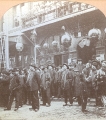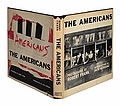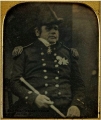| Oct 16, 2010 | Documentary: 19th century Philip Henry Delamotte and The Crystal Palace (1854-1855) | | | |
"The Great Exhibition of the Works of Industry of All Nations" which opened in 1851 was the first World's Fair. It displayed the technological innovations of the age of industry and was a manifestation in physical form of the British Empire. It was housed in the spectacular Crystal Palace designed by Sir Joseph Paxton and constructed by firm of Fox and Henderson in Hyde Park, London. The remarkable structure of iron and glass was a technical achievement and was documented by photographers including William Henry Fox Talbot and Benjamin Brecknell Turner.
Initially it was planned that the building would be temporary and only exist for the duration of the exhibition, just as the Eiffel tower was intended to be temporary, but the exhibition was such an overwhelming success as a crowd-pleaser that it was decided to continue it at Sydenham and so a new and improved building was built. Philip Henry Delamotte, an artist, teacher and photographer, documented the construction as it progressed and his many photographs remain as one of the great series of nineteenth century documentary photography.

PhVTitle | Lightbox | Checklist
Exhibition: Documentary: 19th Century Philip Henry Delamotte and The Crystal Palace (1854-1855)
More about this photographer
| 
| | Oct 16, 2010 | Victorians and Edwardians at War - Help request | | | | We would like to hear from collectors who are able to assist with high resolution scans (160mm wide at 300dpi) of photographs of The Indian Mutiny, the Boxer Rebellion in China, the Zulu War in South Africa and other less well known wars and skirmishes the British were involved in between 1850 and 1910. This is for a book project by John Hannavy and you will get a copy of the book if one of your photographs is used. I'm hoping that that people will have little known photographs to share. If you email me at alan@luminous-lint.com I'll forward everything on to John.
| 
| | Oct 16, 2010 | Robert Frank: The Publications | | | |
With assistance from a Private Collector
The intention in this online exhibition is to provide a reference set of the book covers of works by and about Robert Frank. If you have any additional material we would be most interested.

PhVTitle | Lightbox | Checklist
Exhibition: Robert Frank: The Publications
More about this photographer
| 
| | Oct 15, 2010 | Beauty and the Beast: Human-Animal Relations as Revealed in Real Photo Postcards, 1905-1935 | | | |
This exhibit is the result of a book project in which we used real photo postcards to explore the relationship between humans and animals, 1905-1935. It was during this period that both photo postcards were most popular and Americans experienced profound changes that altered their connection with animals. America was in transition from being predominately rural to a country dominated by cities, from a society where everyday contact with a variety of animals was common to one in which such contact was limited. Cars and trucks replaced horses. Viewing animals, other than pets, came to be done mainly in circuses, zoos and in the movies not in peoples’ own backyards. Food production became industrialized making the animals that are the source of our produce almost invisible. Our book documents the range of roles animals played from pets to vermin. We look at live as well as dead creatures, real as well as fantasy, loved and hated. We explore the contradictions, dualisms and paradoxes of our connection to animals, illustrating how animals were distanced and embraced, commoditized and anthropomorphized.
Robert Bogdan and Arnold Arluke (October 2010)
Arnold Arluke and Robert Bogdan, Beauty and the Beast: Human-Animal Relations as Revealed in Real Photo Postcards, 1905-1935, (Syracuse University Press, 2010), [978-0-8156-3245-2], www.SyracuseUniversityPress.syr.edu

PhVTitle | Lightbox | Checklist
Exhibition: Beauty and the Beast: Human-Animal Relations as Revealed in Real Photo Postcards, 1905-1935
| 
| | Oct 9, 2010 | Julia Margaret Cameron | | | |
Obituary for Julia Margaret Cameron. The Victoria magazine. Conducted by Emily Faithfull., vol. XXXII, November - April 1879, p.585-586.
MRS. CAMERON.—Julia Margaret Cameron, as she loved to subscribe herself in fine bold characters, was in many respects a remarkable woman. A few may still remember her as one of the three Miss Patties, whose varied gifts won for them in Calcutta society the names of- "Wit, Beauty, and Fashion." There she met and married Mr. Charles Hay Cameron, then legal member of Council, who still survives as the last of Bentham's personal disciples. But to most she will be better known as the hospitable occupant of a sea-side house at Freshwater, in the Isle of Wight, whither visitors were attracted by her own talents no less than by the reputation of her venerable husband. During this period of her life she first won publicity, about fifteen years ago, by her bold innovations in the art of photography. It was not only by the intrinsic merit of her pictures, but also by the interest associated with their subjects, that she succeeded in at once taking both the cultivated and the popular tastes. The heads of her neighbours, the Poet Laureate and Sir Henry Taylor, were among the first of her successes. After these came portraits of Browning, Carlyle, Darwin, Sir W. Herschel, and many other distinguished men whose intellectual features lent themselves readily to her peculiar process of photography. Having established her reputation in portraiture, she followed it up with imaginative representation either of individual personages in history and literature, or of easily recognised scenes. Colnaghi's gallery was the regular place of exhibition for her pictures season after season, though they also became familiar in many a shop window of the London streets. In our opinion, among the most effective of all was a fancifully-draped head of a young lady, a relation of her own, to which she gave the appropriate, title of Beatrice Cenci. It must be admitted that her illustrations to, the cabinet edition of Tennyson, published by Henry S. King. & Co., in 1875, do not rank among her happiest works. She did not claim for herself any original discovery in photographic processed. We believe that her only secret was to place her sitter far out of-focus; and to subject the plate to an unusually long exposure. With characteristic energy she worked at all the disagreeable details of chemical manipulation with her own hands, and gradually perfected herself with infinite assiduity. In looking at a series of her pictures it is instructive to observe how her improvement in artistic design kept pace with advance in technical skill. Her first efforts were on a small scale, scarcely larger than the cabinet size now in vogue; and they aimed at little more than faithful portraiture after the style common to all amateurs. Many of them also have sadly altered in colour at the present day. Her latest photographs, such as that of Beatrice Cenci, were almost as large as life. Expression of feature and arrangement of drapery were studied with as much care as by a professional painter in oils. The process of printing was performed with such thorough knowledge and watchfulness that, though these, too, were taken many years ago, no spots and no indications of fading are visible. When Mrs. Cameron, in company with her husband, resolved to follow her dearly-loved sons to Ceylon, her occupation of photographer was abandoned. But soon she sent for her cameras and chemicals, and again set to work with enthusiasm under a less clouded sky. Her death, we believe, happened suddenly, after but a brief illness. She is regretted by an exceptionally large circle of friends, to whom she was endeared by a rare warmth of heart, expansiveness of sympathy, and old-fashioned directness of expression. Few of them but possess some memorial of her in the products of her art, which she was wont to distribute with lavish generosity.—The Academy.

PhVTitle | Lightbox | Checklist
Exhibition: Julia Margaret Cameron
More about this photographer
| 
| | Oct 9, 2010 | Anna Atkins | | | |
"The difficulty of making accurate drawings of objects as minute as many of the Algae and Conferva, has induced me to avail myself of Sir John Herschel's beautiful process of Cyanotype, to obtain impressions of the plants themselves, which I have much pleasure in offering to my botanical friends."
Anna Atkins, Photographs of British algae: cyanotype impressions, (Private publication, 1843-1850)
The monograph is compelling reading - Larry J. Schaaf, Sun Gardens: Victorian Photograms of Anna Atkins (Aperture, 1985)

PhVTitle | Lightbox | Checklist
Exhibition: Anna Atkins
More about this photographer
| 
| | Oct 2, 2010 | Cameras for all (1890-1910) - Request for examples | | | |
I'm planning an online exhibition entitled "Cameras for All" which will include examples of portable cameras and the rise of instantaneous photography between approximately 1890 and 1910. It will include photographs of people using early Kodak and other portable cameras along with publicity materials for the cameras. If you have examples from anywhere in the world I would love to learn about them. Many thanks, Alan
| 
| | Sep 25, 2010 | Newsletter 4.06 - September 24, 2010 has been emailed | | | | Luminous-Lint Newsletter 4.06 - September 24, 2010 has been emailed to all those on our mailing list and you can subscribe to these free newsletters if you haven't already done so.
Past issues of the newsletter are in the library on the Luminous-Lint website. Best, Alan
|
| | Sep 23, 2010 | Portrait: The Unknown Sitter - African American Portraits of the 1860s-1880s | | | |
As the prices for photographic prints declined through the nineteenth century portraits became available for everybody. Studios proliferated within even the smallest centers of population and itinerant photographers travelled in wagons and by train to seek business opportunities wherever they could. With paper-based photographs, such as salted paper or albumen prints, information on the sitter could be written directly upon the paper if required but with those on glass (ambrotypes) or metal (Daguerreotypes, tintypes otherwise known as ferrotypes, melainotypes or Neff plates) a label had to be affixed or the details scratched onto the plate. This was rarely done and so by far the majority of Daguerreotype and tintype portraits are of unknown sitters. Without a knowledge of the sitter or the photographer it can be difficult to establish dates or historical context to advance scholarship.
To raise awareness of this issue this online exhibition shows a collection of portraits of African American sitters that were presumably taken between the 1860s and the 1880s in the United States. We welcome these images being shared to assist in the identification of any of the sitters, photographers, agents and painters involved.
Julie L. Mellby - jmellby@princeton.edu
Graphic Arts Library, Princeton University Library
Alan Griffiths - alan@luminous-lint.com
Luminous-Lint
Update
Stanley B. Burns, MD (Executive Director, The Burns Archive) has kindly provided additional information based upon his book Forgotten marriage, the painted tintype & the decorative frame, 1860-1910: a lost chapter in American portraiture (New York: Burns Press, Burns Collection, 1995) that illuminates how painted portraits of this type were created.
Except in rare cases where an original identified photograph has been kept along with the coloured portrait, normally within a family, the sitters in these portraits are almost impossible to identify. The reason for this is that smaller original photographs, sometimes accompanied with a lock of hair and even more rarely with a printed form specifying how the final portrait should appear, were passed to agents who delivered them to the artist who would create the final portrait. The final portrait was normally larger than the original and this was done by making a photographic enlargement that was then painted. In the case where the painted portrait was framed the back of the frame sometimes had written details on the sitter but over the years as the subject of the painting was forgotten the frame was perceived to have a greater value than the portrait and the two became separated. As soon as this happened the chances of identifying any of the parties involved became increasingly remote.
In the article by Scott Robson "Now hold it" - People and portrait photography, p.48-62 in "Social History and Photography" Proceedings of a symposium held at the Art Gallery Mount Saint Vincent University, Halifax, Nova Scotia (23-23 March 1985), (Art Gallery Mount Saint Vincent University, Halifax, Nova Scotia, 1990) there is an the interesting surviving piece of evidence from Nova Scotia in Canada. An agent Alfred L. Ethrington who collected orders for painted portraits in the Annapolis Valley took tintypes and CDVs and wrote down the customer requests for coloring on forms. These were placed in envelopes and passed to Allister Harlow in Milton, Queens County who copied them, enlarged them, and printed them faintly on paper as a guide and then painted them. The envelopes sometimes included a lock of hair of the sitter along with a detailed form. A rare surviving example of such a form from around 1895 is in the collection of the Nova Scotia Museum (N-14,628).

PhVTitle | Lightbox | Checklist
Exhibition: Portrait: The Unknown Sitter - African American Portraits of the 1860s-1880s
| 
| | Sep 19, 2010 | Scientific: 19th Century Expeditions | | | |
This online exhibition makes no claim to being comprehensive given the vast number of expeditions that were carried out during the 19th century. The intention is rather to stimulate interest in this area for more a complete survey of the subjects. Within this exhibition there are images that will be new to most visitors.
Future additions to this exhibition as we proceed will include:
- Heinrich Barth and his work with the Central African Mission (1849-1855)
- John Hanning Speke and the search for the source of the Nile (1857-1863)
- Robert O'Hara Burke and his crossing of Australia (1860-1861) and John O'Douall on his journey from the south to the north of Australia
- Francis Garnier and the Mekong River Expedition (1866-1868), the travels of Commander Doudart de Lagrée and the expeditions of Henri Mouhot (1826-1861) one of the first Westerners to visit Angkor
- Nikolai Przhevalsky, remembered for the wild horses named after him, whose expeditions led to a far greater understanding of Central Asia (1871-1888)
- Charles Doughty and his memorable travels in "Arabia Deserta" (1876-1878)
- The Swedish explorer Adolf Erik Nordenskiöld and the North East Passage (1878-1879)
- Francis Younghusband (1863-1942) and his work in Tibet
- Mary Kingsley and her explorations in West Africa (1893-1895)
If you have a series on these, or any other scientific expeditions, I'd be fascinated to learn about it.

PhVTitle | Lightbox | Checklist
Exhibition: Scientific: 19th Century Expeditions
| 
|
Ongoing • Newest • Newer • Older • Oldest Mode: LL C_NEWS_CF
|

